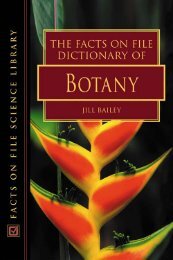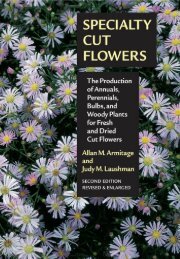You also want an ePaper? Increase the reach of your titles
YUMPU automatically turns print PDFs into web optimized ePapers that Google loves.
pappus (calyx, 8.9) of each floret assists in the<br />
wind dispersal of the numerous small fcuits (8.10).<br />
In mOSt flowers the corolla consists of a<br />
number of petals (8.11) which arc variously modified<br />
to attract pollinators (5.7, 8,6, 8.7) but the<br />
corolla is greatly reduced or absent in flowers<br />
where the pollen is wind-distribured (8.8). In<br />
animal-pollinated flowers nectaries are often<br />
present (3.30, 8.6) and their sugary secretion<br />
attracts pollinators; in many bee-pollinated<br />
flowers the epidermal cells of the petals contain<br />
ultraviolet-absorbing flavonoid pigments which<br />
arc visible to the bee and act as guides to the<br />
nectaries (8.ll). Beracyanins in the epidermal<br />
vacuoles of the petals and carotenoids in the<br />
chromoplasts onen cause bright colouring (8.6,<br />
8.7) which ;)trracrs pollinators.<br />
Petals are usually ephemeral structures with a<br />
thin cuticle and few stomata, while the mesophyll<br />
is usually non-photosynthetic. In actinomorphic<br />
(radially symetrical) flowers perianrh members are<br />
all of similar size and distribured regularly around<br />
the receptacle {1.1, 8.6, 8.11, 8.12}. However,<br />
many flowers are bilaterally symmetrical (zygomorphic,<br />
5.7, 8.7). As with the other floral<br />
organs, the perals are often fused (8.5, 8.13)<br />
although sometimes their tips remain free (5.7).<br />
Androecium<br />
E.1ch stamen is terminated by an anther (1.1, 1.31)<br />
which contains the po11en grains (8.14, 8.16). The<br />
anther is borne on a filament which is eirher<br />
inserted directly onto the receptacle or the corolla.<br />
The filaments are sometimes of unequal length<br />
(8.15), and may be very shaft (1.31) whilst in<br />
orchids filaments arc absent. In some flowers the<br />
filaments arc fused to form a rube round rhe gynoecium<br />
and in the Composirae the amhers are fused<br />
(8.13). A vascular bundle runs along the filament<br />
(8.17) and supplies water and nutrients to rhe<br />
anther. The anther is commonly bilobed (8.15l<br />
with two cylindrical pollen sacs present in each<br />
lobe (8.13, 8.18). The ripe anthers usually split<br />
longitudinally to release their pollen (8.14, 8.18),<br />
but in some plants (e.g. Rhodode'ldron, heathers)<br />
the pollen is released from apical pores (8.16).<br />
In the young anther (8.5) several layers of<br />
hypodermal cells divide periclinally within each<br />
pollen sac to give rise to a central mass of sporogenous<br />
cells and the investing parietal tissue<br />
(8.l3). The larrer differentiates into the hypodermal<br />
endothecium, an intermediate parenchymatous<br />
layer and the tapetum which surrounds<br />
the sporogenous rissue (8.19). The endorhecial<br />
walls normally develop numerous bands of<br />
thickenings on the amiclinal and inner periclinal<br />
walls (S.20) which may be lignified. Most anthers<br />
146<br />
dehisce along specialised longitudinal tracts of<br />
epidermal cells (sromia, 8.18, 8.20) which arc<br />
underlain by unrhickened endothecial cells. In<br />
species such as Phaseo/lts vulgaris (bean), self<br />
pollination occurs in the unopened flower (cleistogamy).<br />
The grains germinate in situ and the pollcn<br />
tubes penetratc the anther wall to reach the<br />
stlgma.<br />
The tapetum plays a vital part in the nutrition<br />
of the developing sporogenous tissue, and consists<br />
of a layer of densely cytoplasmic cells (8.19)<br />
which are commonly bi- or multinucleate (8.21).<br />
In many amhers these cells remain intact but in<br />
species with an invasive (amoeboid) tapetum their<br />
walls degenerare (8.22). As a result a coenocytic<br />
periplasmodium is formed from rheir combined<br />
protoplasts, which direcrly invests the developing<br />
sporogenous cells. Within each anther the pollen<br />
mother cells typically undergo synchronous<br />
meiotic divisions (8.21, 8.22).<br />
In many dicotyledons the four immature<br />
haploid pollen grains lmierospores) formed by<br />
meiosis of the pollen mother cell (microsporogenesis)<br />
lie in a tetrahedron (8.22). Hence each<br />
grain has rhree inner faces in contact wirh thc<br />
orher grains. However, an isobilateral segmentation<br />
pattern is more frequent in monOCOtyledons.<br />
The pollen grain is initially uninucleate<br />
(8.23) bur the first mirotic division, thar often<br />
occurs in rhe anther, divides the maturing grain<br />
into a large vegetative and a smaller generative<br />
cell. In Drosera the pollen grains remain united as<br />
tetrads, but in roe majority of flowering plants toe<br />
four grains separate as roc im'esting callosic wall<br />
of toe pollen mother cell dissolves. In many<br />
orchids and Rhododendron the pollen adheres<br />
together in a sticky mass termed a pollinium (8.16).<br />
The outer wall of the mature pollen grain<br />
(exine) is extremely complex (8.23 to 8.25) and<br />
comprises an inner layer of sporopollenin (nexine,<br />
which is very resistant to decay), and the outer<br />
sexine. The larrer is permeated by sporopollcnin<br />
and is composed of fused rods (baculac). The<br />
exine parrern of different species is very variable<br />
(8.24, 8.25) and of great taxonomic significance.<br />
The inner region of the pollen grain wall is<br />
cellulosic and is termed the inrine.<br />
Gynoecium<br />
In many flowers (8.11, 8.13, 8.14) the carpels<br />
show fusion (syncarpy). In such flowers the<br />
ovaries are united but sometimes the styles remain<br />
separate (8.14) or rhe stigmas are lobed (8.26).<br />
While most floral parts arc generally ephemeral<br />
the ovary, containing the ovules, continues growth<br />
after fertilisarion and develops into the fruit (1.6,<br />
8.27).





